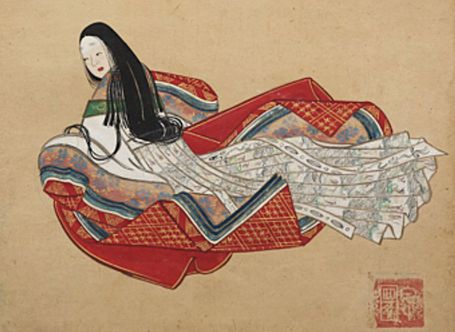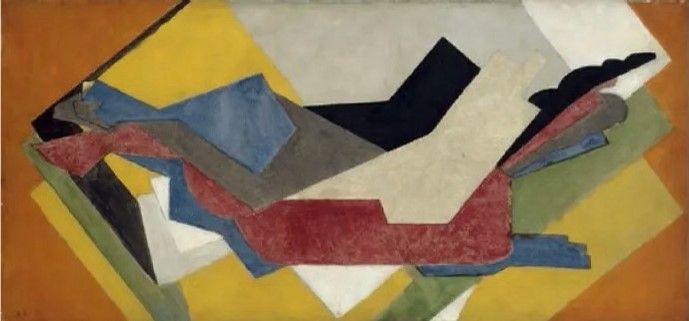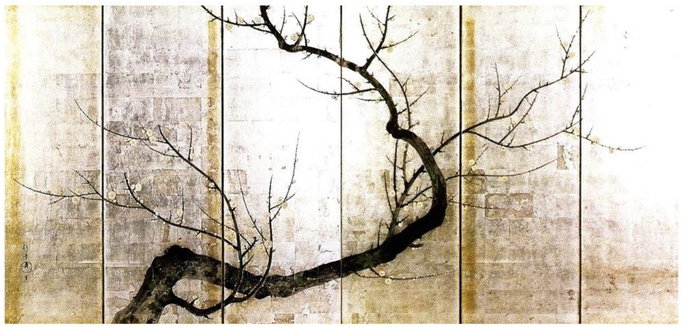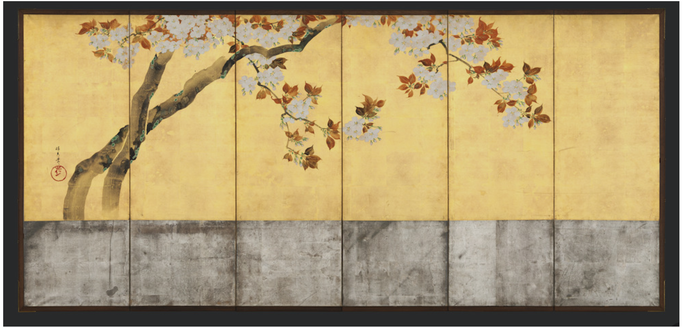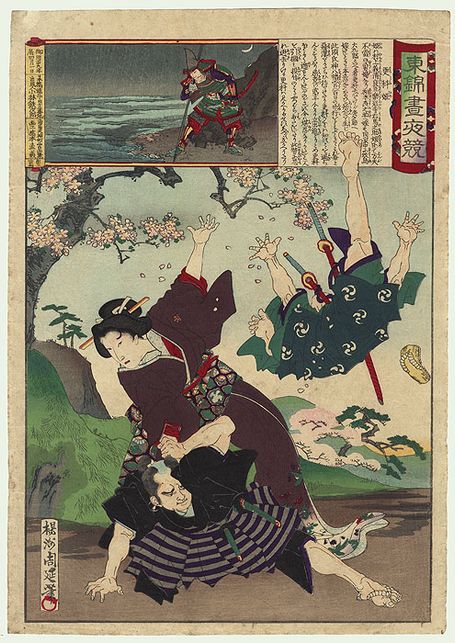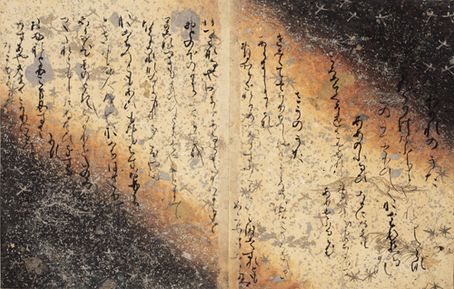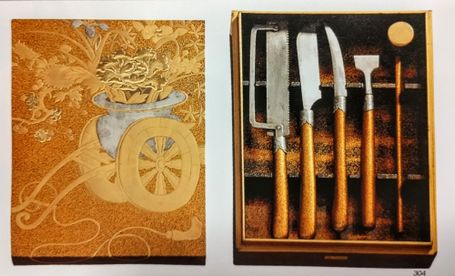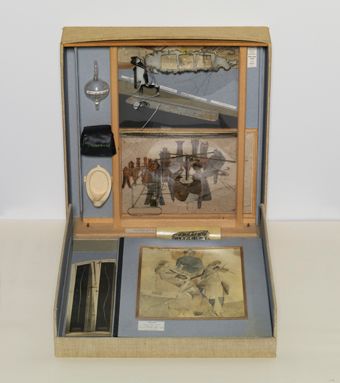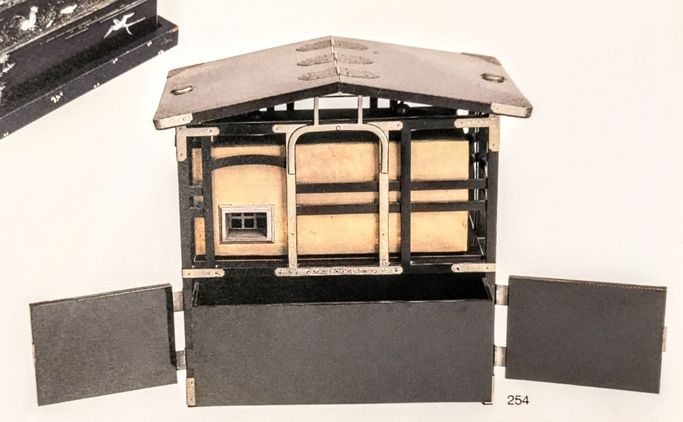Japonisme Insights into Modern Painting I
モダンアート(絵画)のジャポニスム I
Image: Nagasawa Rosetsu (1754-1799), 'Eagle on a Branch', late 18th century, Indianapolis Museum of Art.
Uploaded 2024.9.13; draft composed 2024.9.4, revisions 2024.9.10; further additions and photo annotations to follow
ジョルジュ・ブラック
歌仙絵や折紙で考えるキュービズムのルーツ
Georges Braque (1882-1963)
From Kasen-e to Origami in the Origins of Cubism
Including Examples from the Works of Juan Gris and Pablo Picasso
Yasutaka Aoyama
“The gospel of elimination preached by the print came home to me in architecture as it came home to the French painters who developed Futurism and Cubism. Intrinsically, it lies at the bottom of all this so-called Modernism. Strangely unnoticed, uncredited.”
---Frank Lloyd Wright, An Autobiography, 1943
The French painter Georges Braque, along with Pablo Picasso, according to the standard history of Cubism, were inspired by the later works of Cezanne as well as by African sculpture in their quest for a revolutionary means of artistic expression. While that is true, a strong argument can be made that alongside those influences, Japanese art was also an important collateral factor—if not the critical factor—which supplied the key models for the development of Cubist abstraction.
We will note here only in passing that the influence of japonisme upon Paul Cezanne has been taken up in various research papers and exhibits (e.g. the National Museum of Western Art, Tokyo Hokusai and Japonisme, 2017). Thus, it may be argued, even the influence of Cezanne upon the development of Cubism, whose late works do reflect Japanese pictorial precedents, represents a type of ‘indirect transmission’ of what was originally Japanese inspiration. But that discussion will be reserved for later, in our section on Cezanne. Here we will examine the case for ‘direct transmission’ of Japanese artistic conceptions in Braque’s works. That is to say, we will propose a hypothesis for his conscious adaptation of origami and origami-like imagery via direct observation of Japanese arts and crafts.

Kunisada prints from the mid-19th century
There are many aspects of Braque’s art that indicate Japanese artistic influence: his collaging techniques, which incorporated commercial lettering and fragmented objects into painting, something that had been long done by ukiyo-e artists, such as in their kabuki poster art. Related to that is his ‘papiers collés’ (pasted papers) approach, which seems almost to be a translation of the ‘chigiri-gami-e’ art form of Japan, where torn or folded paper is pasted together to form pictures. Perhaps more fundamentally, the core idea of artistic depiction in Cubism, where objects and people are represented as geometric shapes, often shown from different angles at the same time, happens to be also a good description of ‘origami’—the art of Japanese paper folding—the aspect of geometry in the finished creations of origami, and the aspect of viewing from multiple angles, in rapid succession, in the process of folding origami.
Surely it is not hard to fathom how a variety of objects and people were indeed represented as geometric shapes in origami and its close kin, kirigami, where paper cutting was allowed to create complex shapes. At the very least, modern art historians must admit that there were precedents to the forms they conceived not only in African sculpture, but in origami, which more closely paralleled, and with greater variety and transformational character, much as in Cubist imagery.

Illustration from Kayaragusa, 1845; 2 central images: contemporary origami mask and board pasted origami costumes in the traditional style; an early 20th century New Years’ postcard
Space was Braque’s preoccupation, and that sense of space is highly “origamic”. Here and there in his writings are what could well be interpreted as veiled references to origami, or at the very least descriptions congruous to conceptions of origami. In what John Golding calls “one of his most revealing and lucid statements”, Braque said,
“there is a tactile space, a space I might almost describe as manual”
and that “what attracted me and what was the governing principle of Cubism, was the materialization of this new space which I sensed.” (Golding in Concepts of Modern Art, 3rd edition, N. Stangos, ed., Thames and Hudson, 1994, p. 57) In the words of Golding, “In his first cubist paintings, and indeed in all his subsequent work, it was Braque’s purpose to bring this space forward towards the spectator, to invite him to explore it, to touch it optically.” Or might we say, to perform origami with the mind, within the viewer’s imagination—a sort of cognitive origami, an intangible origami-folding of planes and space.
Origami images became available not only through actual samples of it (sometimes pasted on hard, thick paper sheets as shown among the examples above), but from books, prints, and postcards—the last came to be produced in full force with the turn of the century from the establishment of an international postal service in Japan and the sending of picture postcards from 1900.
But, as we shall see, that is not all. This next point being of vital importance—that such Cubist-like images existed not only in 3-dimensional form as folded paper or images depicting origami as in the images above, but in pictorial forms that were not origami per se, but possessing 'origamic' aesthetic qualities. These range from medieval 15th century suiboku-ga (ink-wash painting) and full color yamato-e style pictures of poets known as 'kasen-e', all the way to Edo period woodblock prints and ‘karuta’ illustrated poetry cards from centuries later. Examples of these will be shown below, together with Braque’s paintings.
Let us first dive into the gist of the matter, those famous early images of Cubism. Braque’s bather, ‘Large Nude’ (1908), is considered by some to be one of the first cubist paintings. Despite the fact that the figure is standing, its similarity to pictures of Japanese female poets in ‘kasen-e’ (sometimes translated as ‘pictures of immortal poets’) and women in erotic ‘shunga’ prints is striking. Women in these Japanese pictures are often wrapped in, or lying in, crumpled kimonos with angular forms echoed in the grey and red forms surrounding Braque’s bather. The influence of shunga art on Picasso, the other leading figure of Cubism, has been discussed at length in books such as the Museu Picasso de Barcelona edited Secret Images: Picasso and the Japanese Erotic Print, (2010); and there is no reason to dismiss that possibility in Picasso’s friend and kindred spirit, Braque, as well. We only need to tilt the picture 90 degrees see the similarity with the manner of Japanese kasen-e painting and later prints, or otherwise tilt the Japanese pictures 90 degrees so that they stand upward.
Large Nude, 1908; Hyakunin Isshu Tekagami (百人一首手鑑) Ise no Taifu (伊勢大輔) c. 1688-1704
But at this stage in Braque’s pictures, it is the backdrop which is origami, and not so much the central figure, much like in the Kasen-e next to it.
In ‘The Pitcher’ (1909), however, the folded paper-like qualities throughout the entire picture are more apparent; especially the triangular tent like formations in the foreground. A medieval kasen-e has been placed next to it so that the parallels can be readily understood. Even the contrast of rounded protruding forms against angular shapes in The Pitcher seem to reflect the rounded shapes of the kimono and hair of the poetess, contrasted here too with the more angular folds of her kimono.
Cards of a hyakunin isshu karuta, mid to late 19th century Saigu Nyogo from The 36 Immortal Poets, c. 13th century, Freer Gallery
In 1910 we see Braque’s tendency towards abstraction deepen; but human figures can still be made out within the geometric fragmentation, as in his ‘mandola pictures’, for instance his ‘The Mandola’ (1910) and ‘Woman with a Mandolin (c. 1910). These, when placed next to Japanese Karuta or Kasen-e images, display a remarkable affinity to Braque, in their central figures within flattened spraying geometric forms.
The Mandola, 1910 Woman with a Mandolin c. 1910

Cards of a hyakunin isshu karuta, mid to late 19th century; Saigu Nyogo from The 36 Immortal Poets, c. 13th century, Freer Gallery
Braque’s ‘Bottle and Fishes’ (1910) below resembles a pile of paper folded constructions, among which origami type folds can be recognized in the structures to the lower right and far right. This, while being extremely Cubist-looking, is also more ‘Realist’ in its 3-dimensionality of forms; that is to say, it is not far from what a realist painting would be of a pile of half completed origami folds.

Bottle and Fishes, 1910
In ‘Still Life with a Pair of Banderillas’ (1911) he has overlayed the geometry with a chipped wood-like surface, decreasing what we might call the ‘Origamic Realism’ of the image, as seen in his Bottle with Fishes, but the paper folded-type angles can still be made out.

Still Life with a Pair of Banderillas, 1911
In his works during the following years, the paper-based nature of his conceptions is quite literally expressed. This style of his has been referred to as ‘papiers collés’ (pasted papers), part of what has been known as his ‘Analytic Cubism’ phase. His ‘Still Life Bach’ (1912) mixes wood-like textures with paper. Likewise does his Violin and Glass (1913); the wood plates seem like substitutes for what is fundamentally a conception derived from a pile of overlapping compact rectangular sheets of paper. While in his ‘Bottle of Rum’ (1914) sandpaper type sheets, clearly paper-like in their folded and cut manner, have taken on the same role.

Still Life Bach, 1912; Violin and Glass, 1913; Bottle of Rum, 1914

Anonymous Japanese omocha-e print of a chiyogami collage, mid to late 19th century; New Years’ advertisement, 1st decade of the 20th century
Nature Morte Fruit Dish Ace of Clubs, 1913; Glass Carafe and Newspapers, 1914
His ‘Nature Morte Fruit Dish Ace of Clubs’ (1913) mixes various elements and textures including playing cards and their symbols, adding complexity by detail, almost in an attempt, it seems, to obscure the fundamental equivalence of the conceptual basis of the work with the others. So too does his ‘Glass Carafe and Newspapers’ (1914), reminiscent of chigiri-gami-e, mix some of the previous elements and new elements—this time newspapers; but again, we might ask, are these are all interchangeable substitutes for the archetypal folded paper—origami and kirigami?
Between Fauvism and ‘Analytic’ Cubism: Braque’s Suiboku Phase 1908-1909
It is not only in the origami correspondences that leads us to Japan in the work of Braque, especially in his earlier works, before 1910. There are correspondences with suiboku (ink wash painting) in Braque, observations made of works akin to Cubism. For anyone familiar with the 15th century master of suiboku painting, Toyo Sesshu, the kinship of ‘The Church of Carrières Saint Denis’ (1909) to his ‘Shuto Sansui-zu’ (秋冬山水図 15th century) is unmistakable. Braque’s paintingreflects the same vertical division of landscape that makes Sesshu’s piece so iconic, and the most celebrated work of Sesshu, and so much of the two works are reflective of each other that no reasonable mind could be led to conclude Braque had not seen it. Note the luminous, smooth yet pronged jagged masses on the left in both pictures; the flattening rivers to the lower right in both with a prominent rock or rock-like mass in the foreground; even stairs are in both landscapes though situated and scaled differently; but more importantly, the general compounding of angular formations and perspective confounding interlocking of angles and lines, merging with the spatial continuum, all create a mystical and disconcerting sense of space. Indeed, Sesshu’s masterpiece might be considered the first Cubist work ever, in the very sense Braque and Picasso conceived it.

The Church of Carrières Saint Denis, 1909; Shutosansui-zu, early to mid-15th century
Braque’s ‘Viaduct at L’Estaque’ (1908) below, reminds us of another iconic suiboku work by the 18th century literati painter Yosa Buson. In Buson’s winter scene of a village on a hillside, the ‘Yashoku Rodai-zu’ (夜色楼台図), we find the same simplicity of outlined jumbled roofs, looking much like folded paper, submerged into amorphous masses of paint and vegetation. The skillful simplicity of approach in coloring is also analogous. The parallel is obscured only by the addition of the looming aqueduct in the background, without which Braque’s picture could become a colorized extension of Buson’s painting.

Viaduct at L’Estaque, 1908; Yashoku Rodai-zu, 1778
Braque’s Fauve or Contemporary Japanese Prints Phase 1905-7
Furthermore, one of the persuasive arguments that Japanese art was likely to have been a factor in Braque’s cubism is that japonisme influence can be seen elsewhere in Braque’s work, before his cubist phase. Braque, who saw the Fauve art of André Derain and Henri Matisse at the 1905 Salon d’Automne, started to paint in a similar fashion. The artists of the ‘Fauve,’ meaning beast, were seeking to express the feelings that nature inspired in them through more strident, savage colors, partially due to the influence, it is generally claimed, once again, of Cézanne. Cézanne however, does not quite explain the shift; they are in fact closer in their fluorescent quality to the Meiji era Japanese prints of the time. Braque’s ‘Olive Tree near L’Estaque’ among several other like it shown below, painted at L’Estaque or La Ciotat, or his ‘Nude Woman Seated, Back’ (1907) though not included here, reflect ukiyo-e compositions and especially the coloring trends of late Meiji prints, which often contrasted brightly luminescent with dark hues in landscapes. Not only were trees in shocking pink, but horses and fishes too; clouds might be glaring red and purple; buildings, streets, and floors in solid yellow or red, with figures clad in glowing orange, baby blue or any of the aforementioned colors.

The latter of these inexpensive prints, often of the hikifuda poster type, using more modern printing technology, were mass produced in much greater quantity than previous woodblock prints, probably in the hundreds of thousands, and would have been readily accessible to visiting foreigners at the time.
Juan Gris and Pablo Picasso—Similar Japanese Sources
Another reason for concluding that Japanese art was one of the sources of inspiration for Cubist conceptions is the indication that key artists of Cubism besides Braque were also influenced by Japanese art of the kind shown earlier, such as the kasen-e of poetesses, subsumed in masses of angular kimono forms.

Juan Gris, Grapes, 1913; Nyobo 36 Immortal Poets Byobu, detail, 17th century, Saigu History Museum (女房三十六歌仙図屏風 斎宮歴史博物館)
There are various cross references of color, form, composition, pattern variation, and texture in the Spaniard Juan Gris (1887-1927)’s well known Cubist painting ‘Grapes’ (1913) above to the images on the byobu (folding screen) painting shown next to it, with typical depictions of the 36 Immortal Poets. The japonisme of Gris, Leger, and Picasso and cannot be adequately discussed here, all requiring separate treatment, and a similar analysis to Braque of their works will eventually be presented.

Kasen-e of Shikishi naishi-o, 16th cent., Kyoto Cultural Museum; Picasso, Queen Isabella, 1908; Picasso, Seated Man with his Arms Crossed, 1915; Torii Kiyotada, actor print, 18th century
Tsuyama Yuzo, Chushingura Origata Denjusho (origami warriors), 1801-1804, Meiji era reprint, Ritsumeikan Archives of Ako City; Pablo Picasso, La Danse, 1946
One is lead to the conclusion that a primary force in the development of Cubism was the ‘discovery’ by European artists in the early 20th century of ‘non-ukiyo-e’ Japanese arts such as the kasen-e and origami, as well as more recent, atypical prints as the omocha-e (‘toy pictures’) and other Meiji Period prints by lesser-known artists which the Impressionists and Post-Impressionists had not discovered or had yet to come (though this does not preclude ongoing inspiration from classic ukiyo-e images as those of shunga prints as in the case of Picasso, but seen in a new light). This certainly seems to be the case for Fauvism, which must also be considered in a separate discussion, but the chromatic parallels with late Meiji prints of the 19th century shown earlier and those of the Fauvists and their contemporaries of the early 20th century are unmistakable.

Robert Delaunay, L'homme a la tulipe (Portrait of Jean Metzinger), 1906; André Derain, Madame Matisse in a Kimono, 1905
Concluding Remarks
The birth of Cubism has come to be recounted as a heroic saga, with its evolutionary progression imbued with an aura of almost imperative logic by its clever use of mathematical-sounding terms that evoke implicit associations to analytic and synthetic geometry.
In ‘Analytic Cubism’ color is de-emphasized, restrained to Oribe style tea ceremony ware chromatics—often shades of olive green and grayish-beige. Forms are fragmented, facets of shapes merging into the surrounding continuum, yet maintaining recognizable subject matter, suggested by the orientation of the planes and their origami-like edges. This, however, in no way is a serious analogy to analytic geometry, yet the name alone gives it an aura of ‘there must be something of profound math-like complexity in all of this, taxing my comprehension’.
Perhaps even more intimidating to the novice is the term that refers to the next stage of development, ‘Synthetic Cubism,’ evoking by verbal association, synthetic geometry. In this ‘highest stage’ of Cubism, ready-made materials such as wallpaper and newspaper clippings are incorporated into the images, often leaving the backdrop of angular folds and extending planes, but with solid colors making a comeback—darker, sometimes patterned such as faux-bois as found in his ‘pasted-paper’ pieces, or at other times textured like sand. Mundane, drawn in figurative details, as well as curved lines, are also part of this phase. In that sense it is even more eclectic than before, and hence the name ‘synthetic’. But the logical distinction between the two, analytic and synthetic, is in fact imprecise. What is more certain is the baffling effect these terms have on the reader when he first encounters them. The creation and naming of this ‘Synthetic Cubism’ along with that of the ‘Analytic,’ is one of those perfect examples of what we might call ‘modern art scholasticism,’ which weaves in intellectual complexity for its own purposes (like medieval scholasticism), confounding better, more direct explanations of artistic phenomenon.
And it is a rather coy verbal sleight of hand at that; for without openly claiming or insisting on any formal connection to mathematical principles in the development of Cubism, using the two terms ‘analytic’ and ‘synthetic’ in combination with the classic polyhedron (i.e. cube), to adjectivize a progression in art—while there already exists such a pair of terms corresponding to the categorization of progressively higher geometries in math, is an association readily made that can hardly be avoided on the implicit level of human consciousness. It works whether or not one has taken a class in analytic or synthetic geometry, perhaps better if one has not; surely it is one of the cleverer forms of cognitive-psychological suggestion and intellectual intimidation in art history.
However much a blow to his cherished preconceptions, if the reader looks once more at the evidence, and allows the rational (not rationalizing) side of himself to view the matter, the question of japonisme (though based on different Japanese art sources from that of the previous Impressionists and Post-Impressionists), should appear as an issue requiring serious consideration in any discussion of the origins of Cubism.—Which, by the way, perhaps is more aptly called ‘Origamism,’ as in fact there are so few actual cubes and so many more paper folds in Braque’s and the others’ paintings.
_____________________
Uploaded 2024.8.25, inception spring 2023
Preview
Jacques Villon (1875-1963)
Origami Perspectives
Origami Transformations
Origami Conceptualizations
Yasutaka Aoyama
Origami/kirigami as generator of abstract art. The example of Jacques Villon, Cubist painter and printmaker. Younger brother of Marcel Duchamp part of the artistic family of talented family his other siblings Raymond and Suzanne The other Duchamps, besides Marcel, were artists in their own right.
Jacques early works as a graphic artist for magazines and newspapers in Paris are very much in the japonisme tradition of poster art taking from Lautrec and others discussed in surveys of japonisme in the 1890's and first years of the 1900's. Emphasizing clear divisions of color and lines he is known for his abstraction of form from observation of from life, of landscapes, still lifes, and figures. He became friends with Fernand Leger and other avant garde artists, taking part in the artistic "cross pollination" going on at that time. In many of his works the influence of origami---folding---is prominent; at other times the influence of chirigami---tearing---is more so; and in other works we find both elements.
Text, photo captions to be added.
_____________________
Uploaded 2024.8.30
Under construction, partial draft
Text to be added and revised, image captions to be further annotated
マルセル・デュシャン
極限的な抽象化を追求したそのジャポニスム
Marcel Duchamp (1887–1968), Part I
Abstractive Japonisme
Yasutaka Aoyama
In this author’s opinion, when surveying the corpus of modern Western art, few artists rival, if any, Duchamp in their congruence of forms and compositions to traditional Japanese arts and crafts with such pervasiveness. So fascinating are the parallels between Duchamp’s artworks and traditional Japanese arts that, despite the transformations Duchamp has performed on them, the two retain a deep, fundamental resemblance, which, when recognized, hit the observer with a happy stroke of ‘a-ha!’ type illumination.
So abundant are these parallels in the case of Duchamp that this author has been overwhelmed with attempting to document and organize them in a complete manner, leaving this work mid-way for other research. A substantive analysis would take a great amount of time; a few examples are provided below to give a hint of the iceberg that lies below. And while exhibitions such as 'Duchamp and Japanese Art' (The Tokyo National Museum, 2018) have compared Duchamp and traditional Japanese conceptions of art, pointing out the idea of 'ready-mades' as having their precedents in Japan, the majority of the juxapositions provided are arbitrary and frivolous, passing over the critical parallels of imagery and form provided in this discussion, and never suggesting any substantive Japanese influence. Only the Sharaku comparison with Duchamp's 'Portrait of Dr. Dumouchel' (1910, shown below) was included in that exhibition, but without the kind of observations made here.
In the intervening years since this author left this research, his files, photos, and books related to this topic have gone missing; the question now becomes whether fragments of those observations are to be recorded and published in unfinished form, or never at all.
Significant parallels clearly alluding to Japanese art can also be found in the works of Francis Picabia, whom Duchamp admired, a topic for future discussion.
Ukiyo-e / Manga and the Current of Japonisme Influences in Duchamp's Early Years
The first decade and a half of the 20th century was the heyday of japonisme portraiture of Western women in Europe and America. Almost every artist, it seems, painted one or more pictures of women in kimonos in that period, and Duchamp too was not untouched by the fervor of that trend, as seen in his paintings of his sister Yvonne in kimono attire, which are some of his earliest memorable works. In them, we see his use of the technique of blotting out areas in the picture surrounding the subject, creating a backdrop without connection to the actual surroundings the subject was situated in; this was a conspicuous characteristic of Japanese ukiyo-e prints, a technique whose use Manet is known for, among many other impressionist artists and those who came after them.
Hokusai in Duchamp
Hokusai's rather simply formed body shapes, as if drawn with one long continuous stroke, without taking the pen off the paper, are reflected in the plump figure of Duchamp's 'Japanese Apple Tree' (1911). Duchamp's character reminds one of a meditating bonze, of the type by Hokusai (shown left). Duchamp's 'bonze' sits under a tree, in a classic 'under the bodhi tree enlightenment' type composition. The neckless, stubby figure of Duchamp's painting can hardly be disassociated in the mind with those of Hokusai's manga figures, once juxataposed, of which only a few examples have been provided for comparison.
Below, note the particular body forms that characterize Hokusai female bathing figure in the upper left hand corner of his manga sheet in Gonse's reproduction of Hokusai, and the reddish figure in the upper right-hand corner of Duchamp's painting, 'Baptism' (1911). Putting aside the obvious differences in arm positions of the two figures portrayed, observe the broad, smooth, lumpish singular nature of the buttocks; the reddish figure's bent back leg like that of Hokusai's woman; the hand placed on a white object on the edge of a stone wall reminiscent of the white towel on the edge of the wood basin onto which Hokusai's figure places her hand; and the head twisting backward. Even the belt-like line on the Duchamp figure seems to mirror the prominent black sash on Hokusai's bather.
Duchamp's woman in the lower left of 'Baptism' echoes ukiyo-e images of women bathing themselves in shallow, round 'taru' basins of wood, as in Torii Kiyomichi (1735-1785)'s print shown to the right of Duchamp's painting. The pose of Duchamp's woman reaching down to wash the lower legs or feet is typical of ukiyo-e bathing scenes, as in Kiyomichi's print. Ukiyo-e bathing scenes made quite an impact on European artists, including Honore Daumier, in this author's opinion.
Sharaku in Duchamp
A comparison of Toshusai Sharaku's actor print (1794) and Duchamp's painting 'Portrait of Dr. Dumouchel' (1910)
Positing Duchamp based his 'Portrait of Dr. Dumouchel' on Sharaku's actor portrait shown to the left, note how the traces of Sharaku remain; the red around the eyes, though in a wider circle; the strongly pursed lips; the glance forward with the eyes at the inner edge; the hair bulging at the back;the long neck which makes straight lines into the chest and clothes--there is no adam's apple, just a smooth surface; the dark knife like shadow of the sideburns reflecting Sharaku's curved sideburns; the same tone of greyish backdrop, though the violet/reddish tones have been added.
A Japonisme of Compositional Aesthetics
Duchamp it appears, learned not only from the big names in ukiyo-e art, such as Sharaku or Hokusai, but also from artists making a variety of poster art type prints, or silhouette prints, and other less heralded woodblock prints. Japanese prints in fact, exhibited a great variety of compositional styles, including collage techniques before they would become common in the West. Other artists were already learning from the example of Japanese collage, such as Matisse.
Above: Similar color tone combinations, analogous compositional constructs, and combinations of faces or figures in floating circles, intersecting with square, perpendicular lines, writing, dispersed and clustered, in different calligraphic styles, often boxed, other shapes hanging, such as the small red chochin lamps and emblems in the ukiyo-e as opposed to diamond shapes, or price stamps in Duchamp.
Note the eerie resemblance of the profiles—not so much in terms of a physiognomic fit, but rather the psychological effect they convey from an analogous graphic technique. Shared features include: the smooth, rounded forehead coming flat down with de-emphasized eyes, reaching almost with minimal interruption to the sharp noses followed by unexpressive lips; the square stamps and cursive writing within the picture, the vaguely discolored/rough grained feel of the blank parts of the paper, and the thick framing as part and parcel of the picture. The Japanese print example above may not be the best, but serves its purpose. There are prints which, like the Duchamp image, only a portion of the head is included. The above indicates that Duchamp may have still looked to Japanese prints for inspiration in his latter years.
Duchamp's Byobu-e and Suiboku Abstractions
A comparison of Sakai Hoitsu (1761-1829)'s byobu screen paintings and Duchamp's famous 'Network of Stoppages' (1914).
Text to be added.
Sakai Hoitsu, Sakura-zu Byobu, between 1815-20, Burke Collection 「 桜図屏風」
Duchamp's 'Chess Game' as a Fragmental Kinkishoga-zu
Ever since the Hikone Byobu, the depiction of Japanese chess/go players, together with other figures relaxing nearby, has been a perennial favorite in Japanese art, not only on byobu screens, but in ukiyo-e prints, for instance the one by Mizuno Toshikata (1866-1908) shown below. Note how in the Hikone Byobu there is besides the board game players, a tea set and a female figure resting on one arm, as in Duchamp's picture. These elements are found repeatedly in the Kinkishoga genre, meaning 'Harp, Chess, Calligraphy, and Painting'. This theme continued to be popular in the late Meiji and Taisho periods around the time Duchamp produced his Chess Game, that is in the early 20th century (e.g., the Kinkishoga-zu of Kanemori Kanyo 1884-1932, also with the same elements mentioned above). The backdrop of Duchamp's Chess Game, however, is most similar to the Hikone Byobu, in terms of its kinpaku (gold leaft) backdrop with its patchy gradations, and the consistency with which it fills the spaces between the characters and their furnishings/objects, despite the former done in greens and the latter in golds. Images of the famous byobu would have been readily available by the early 20th century in introductions to Japanese art, published in European languages.

Mizuno Toshikata, 'Kinkishoga-zu', 1889
Duchamp's 'Pharmacy': Intimations of Suiboku---Ink Wash Painting
Pharmacy was an unsigned watercolor picture to which Duchamp added his name and a title. If we are correct in surmising that Duchamp had a strong attraction to Japanese art, one might suspect that among the reasons he took a liking to the watercolor (above left), enough to wish to make it his own, was in part the oriental quality of it. Tani Buncho's Sanzui-zu is provided for comparison. The red with white, and black with white dots in the distance in Duchamp's picture (which this author guesses were added by Duchamp), seem to be faint echoes of the two figures in Buncho's picture (or many others like it), with a sage in red and white and his young assistant in blue and white who follows him, walking near a river visible between leafless trees. Pictures like these, of dimunitive depictions of sages walking through forest, river, and mountain landscapes were an extremely popular genre of Chinese and Japanese ink wash painting.
Japanese Style Repetitive, Geometric Formations in Duchamp's Abstractions
Repeating Circular Forms
Duchamp's circular forms below resemble at times Japanese spinning tops, or folded chochin lanterns, or katori senko, or katagami patterns, among other common designs and iconic Japanese images (such as a fish in a fishbowl viewed from above). The prints shown below Duchamp's circular images are late Edo period prints of distorted images, one of many types of toy or trick images popular in the 19th century. As in some of his other works, a connection to Japan, like a clue, lies discreetly placed in this creation, too.
Repeating Rectangular Formations
Below, a print by Toyohara Kunichika (1835-1900) of actors throwing connected sheets of folded paper, in what may be called Edo period 'performance art'.

Toyohara Kunichika, 1884 (日吉将軍高吉 市川団十郎,、高吉の政所 中村福助など 植木林之助版 大判三枚続)
Regarding Duchamp's painting 'T'um', shown below, a BBC article lauds it as revolutionary: "In 1918, the French avant-garde artist Marcel Duchamp picked up his brush after a four-year hiatus from painting and created a mysterious work that changed forever the way artists use and understand colour. After completing his painting, Duchamp put his brush back down again and, for the next 50 years (until his death in 1968), never painted another picture." (BBC, 'The mysterious painting that changed how we see colour' by Kelly Grovier, 15 February 2018, at bbc.com/culture)
Let us now posit Duchamp's 'T'um' as abstractive of the image (or one like it) shown above by Toyohara Kunichika. We can then see how not only the layered sheets of paper resemble those thrown by the actors, from the upper left hand corner angled diagonally downward to the right, but the sense of movement of those papers from the left to the right is also indicated by Duchamp's pointing hand, and the odd shadow like squiggley form behind it, along with his wavy shapes below it, pointing also to the right, both which echo, by the way, not only Duchamp's other artworks, but also the clearly outlined water lines in Kunichika's ukiyo-e print.
Likewise, if we now look at the colorful small rectangular domino-like formations in linked rows in Duchamp’s picture to the right: these too seem to reflect the similar rectangular domino-like ruffles also in spraying rows merged with the extremely colorful vestments of the couple in Kunichika's picture. Once again Duchamp places a shadow image of one of his other artworks here, overlapping with the rectangular formations, an addition of his not derived from the Kunichika picture, and part of Duchamp's trademark style of incorporating his previous works into new works.
That aside, comparisons might even be made with the jagged, torn section in the middle of Duchamp's painting and the green, ragged splotch in the Kunichika picture, also in the center dividing the two clusters of figures, which also starts from the last paper sheet fold leading to the group of images to the right. We should also point out that the basic compositional spacing is also similar to Kunichika: along a more than usually wide picture, two thirds or so is devoted to the extending rectangular and wavy forms, and one third or so devoted to the more intricate designs to the right.
Various other observations might be made. Duchamp's square sheets certainly do remind anyone familiar with origami packets of the more top of the line extensive origami sheet sets, which are so comprised of squares of subtle variations of hues, and sometimes displayed as Duchamp's squares.

Duchamp 1918
The Kunichika picture is but one of many possible sources that are suggestive of the kind of repetitive, asymmetric, geometric imagery that Duchamp employed. The byobu screen of floating hyakunin isshu cards below is another example of this tradition of design in Japan.
Repeating 3-D Interlocking Forms
These forms are also related to origami conceptualizations. The combination of contrasting forms, those clustered vs. those singular, should also be noted.
Increasing Abstraction of and from Ukiyo-e Prints
From perhaps the mid-1910's, one notices an increasing level of abstraction in Duchamp's art, yet still analogous to ukiyo-e, manga, or other Japanese visual imagery.
Capturing Mid-air Moments
Text to be added. Splaying fish fins, twig bundles or limbs and fingers pointing upward, as a sort of mid-air ensemble compared to works of Duchamp, to be discussed.
'Contraptional' Pictures
Artists engaging in the depiction of similar systems of linked contraptions as art, has its precedents in Japan. Text to be added.
Spinning tops, spheres, wheels, umbrellas or disks, whirling apparatus, rolling balls triggering chain reactions, interconnected contraptions, ladders, balancing ropes, stacked objects, etc. were part of the key attractions of the leading circus and daidogei artists (street performers) of the time, such as Hayatake Torakichi and Naniwa Matsunosuke. They were often depicted by the most popular Utagawa ukiyo-e school artists such as Kuniyoshi, Kunisada, as well as Yoshiharu, Sadafusa, and later by Kawanabe Kyosai.
Duchamp's Diversification of Japonisme Sources
Japanese Architectural Elements and Duchamp
Kaya, sudare, shoji, and other artefacts and forms from Japanese architecture and interiors are reflected in Duchamp's works.
The Chromatics and Forms of Washi Paper and Duchamp
Karuta and other Japanese 'Cards in Box'-type Conceptions and Duchamp
Echoes of Ancient and Iconic Structures of Japan
Duchamp's various whimsical 'ready mades', while at first glance might seem somewhat randomly chosen, without any overarching theme, almost always mirror some kind of iconic Japanese design or artefact, from his hanging ampoules '50 cc of Paris Air' (1919) analogous to tinkling summer breeze glass bells called 'furin', all the way to soaring Buddhist temple towers called 'gojunoto'.
Japanese Temple Architecture and Duchamp
Yayoi Sculptural Forms and Duchamp
Duchamp and the Siebold Collection
The aesthetic parallels between the Siebold Collection exhibits and the works of Duchamp are too numerous to recount with any justice here. What one might hypothesize from a comparative study of Duchamp's later works and the Siebold Collection exhibits is the following: Upon seeing how the everyday, at times extraordinary but at times utterly ordinary, but by the fact of being from another country of another age, become valuable artworks if displayed with care, he was hit by a realization of the arbitrary and transformative power of 'exhibiting as art as equivalent to being art'; i.e., the power of artistic definition, the importance of context, and conceptualization of something as art being the essence of Art itself. At the same time, he found the forms, conceptions, and designs in Japanese culture to be unique and particularly pleasing, and continued to use their forms, or find analogous artefacts in his own culture, as the basis of his creations. Some examples not from the Siebold Collection are also included for enhanced perspective on the Duchamp pieces.
_____________________
We need your consent to load the translations
We use a third-party service to translate the website content that may collect data about your activity. Please review the details in the privacy policy and accept the service to view the translations.


